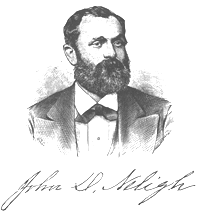History of Neligh
John Neligh, an inventive and imaginative brick maker from West Point, Nebraska, traveled with two companions to Antelope County in 1872 and was impressed by the scenery. While he and his friends looked at the Elkhorn River, bordered by cottonwood trees, they also noticed an uninhabited valley filled with clumps of green and gold grasses swaying in the August breeze. Neligh decided that the area favored a town site and traveled to Omaha to buy the land, where he found that the Omaha & Northwestern Railroad had already chosen the property for a future town and depot location.
Fortunately, a careless clerk failed to check the railroad’s choice of town locations, allowing Neligh to purchase the 500-acre tract for $6 per acre. His friends encouraged him to name the town Neligh. He immediately arranged to build a brick flour mill and a dam across the Elkhorn River. He also installed machinery for a sawmill. The town was founded by the Honorable John D. Neligh, William B. Lambert, and John B. Thomson in 1873. After the county seat dispute with Oakdale was settled in 1883, the fledging town prospered.
Located in the middle of Antelope County, Neligh became the center of county government. Major improvements in milling occurred with each new owner of the Neligh mill, and unlike mill in some neighboring towns, it survived the Great Depression. Now the mil is an area tourist attraction. Neligh reached its population peak of 1,800 in 1980. The 2010 census reported 1,599 Neligh residents.
The Mill
Shortly after founding the town, Neligh located his mill in the southern part of town. The original two-story mill was built with bricks made by John J. Crawford, using local clay. When the financial panic of 1873 interrupted John Neligh’s plans for the town he had founded, he returned to West Point, Nebraska, selling his Neligh interests, including the mill, to William C. Galloway and William B. Lambert. By 1882, the mill had a capacity of 250 bushels a day. In 1886, steel rollers replaced the stone-grinding burs, producing more finely ground white flour and new machinery that increased the daily output to 500 barrels. He also purchased equipment that supplied electric power to Neligh citizens. As large corporations began taking over flour production, the operation ceased milling flour in 1952 but continued to produce livestock feed. In 1965, the mill closed its doors. The persistent efforts of Neligh citizen Margaret Pierson brought the mill and its machinery to the attention of the Nebraska State Historical Society, and the mill is now a Nebraska State Historical Site.
Stealing the Courthouse
The first towns in Antelope County, Oakdale and Neligh, engaged in a 10 year feud over the location of the county seat. In 1871, Oakdale settlers failed to stipulate a county seat during an election for the county’s organization, while John Neligh’s messenger carrying the petition to name Neligh as the county seat lost his way en route. In 1872, state officials declared Oakdale the county seat. Neligh challenged their choice in four election and won the final vote in October 1883. Neligh began serving as the government center on January 1, 1884. After a mill levy passed, work began on the official structure, with the total cost not to exceed $1,500. Fred Thornton was the architect, and T.H. Benton supplied bricks from his Neligh brickyard. The building was dedicate on January 8, 1885.
Gates College
In May of 1881, the Columbus Association of Congregational Churches met at Oakdale to offer to maintain a college in the area. Two large bids were put forward by Neligh and Oakdale. Neligh’s bid of $7,000 and forty acres of land was chosen. The college was named for H.N. Gates, Superintendent of the Congregational Churches of the State. The main building stood on a hill northeast of town. Gates became a college in 1892, attracting students from across the country. It was the only Nebraska college between the Platte River and the Dakota Territory for several years. Gates became an academy in 1899 and was discontinued in 1914.
For more information please contact the Antelope County Historical Society at (402) 887-5046.
Historical infromation and images taken from Marie Krohn's "Images of America: Antelope County" available for purchase online, Antelope County Museum, and the Neligh Library.
And also from from "Andrea's History of the State of Nebraska."
Visit these additional resources for more information on Neligh and Antelope County:
- "History of Antelope County Nebraska 1868-1883" by A. J. Leach
- UNL's Virtual Nebraska - Antelope County
- Nebraska State Historical Sites in Antelope County





 Launch the media gallery 1 player
Launch the media gallery 1 player